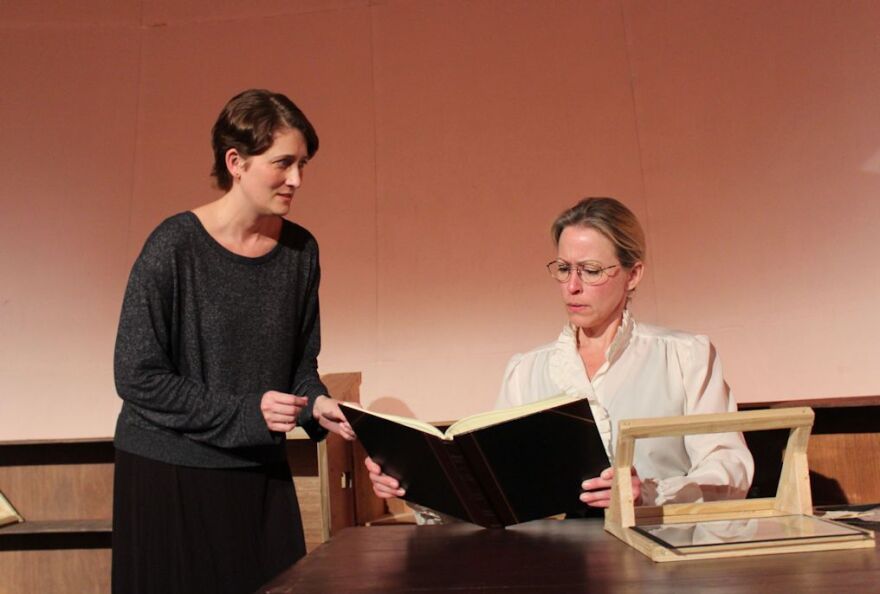The story of NASA human computer Katherine Goble Johnson is well-known today thanks to Theodore Melfi’s Academy Award-winning film, Hidden Figures.
A new play seeks to do the same for a coterie of female astronomy computers who toiled in a sparse workroom a floor below the Harvard Observatory in the early 1900s.
The figures featured in The Women Who Mapped the Stars worked for Edward Pickering. He served as Director of the Harvard Observatory from 1877 until his death in 1919.
During this time, he pioneered the use of astrophotography to capture the night sky. It fell upon Pickering’s female computers to analyze and catalog the stars that he and his male astronomers captured on glass plates.
“They would distill all that information,” amplifies Planetarium Educator and the play’s director, Todd Sherman. “So really the ladies were doing the real work.”
The work was tedious, routine, unglamorous.
They put in six-day workweeks, then went home to take care of their husbands, children and homes. And Pickering’s Harem - as they were derisively known by the Director’s patriarchal contemporaries - never even got to see the stars through the Observatory’s telescopes.

Williamina Fleming managed this team of female computers. Before Pickering appointed her in 1881 to replace his ineffective male assistant, she was his maid. Yet, over the course of her 34 year career at the Observatory, she rose to the position of Curator of Astronomical Photos.
She’s played in the docudrama by Lauren Drexler. What impresses Drexler most about Fleming and the other women depicted in the play is their strength of character.
“They got up each day. They worked. They had obstacles,” Drexler notes.
“They didn’t let it stop them, deter them. They moved forward. They accomplished great things. Overcoming obstacles…”
…Obstacles including physical infirmities.
“Both Annie and Henrietta were deaf,” notes Stacy Stauffer, who plays Annie Jump Cannon. “They both had illnesses that … caused both of them to be deaf. So you had two women who had other struggles.”

During the 1920s, few women went to college or worked outside the home. Those who did made less than half of what their male counterparts were paid.
That didn’t sit well with fellow computer Antonia Maury, who says at one point during the play, “it’s barbaric. In 1999, yes, mark my words, in 1999, the women will be paid what men are paid, and everyone will look back at us appalled.”
Worst of all, Pickering and his male astronomers took credit for the women’s discoveries.
“These ladies were making incredible discoveries, and because of the discoveries they made, we now know things about the stars that we did not know before. But they were never credited with their own work,” remarks Director Todd Sherman.
“They created the astronomical catalog that we use today, the entire spectral series that we use today. They discovered how variable stars work."
"Edwin Hubble and Harlow Shapley, in 1925, figured out the distance to the stars using that information, which we hadn’t been able to do before, and the woman who figured all that out was then sent on to another project and wasn’t able to use her own research to do what they did.”
Beyond riveting personal stories and a tantalizing slice of astronomical history that possesses the same allure that made Hidden Figures so popular, what makes the upcoming production of The Women Who Mapped the Stars unique is the setting chosen by Theatre Conspiracy at the Alliance for the Arts.
Instead of staging the docudrama in a conventional theater, the play will be performed in the Planetarium at Calusa Nature Center. & Planetarium. That excites the entire cast.
“How many people can say they performed a play in a planetarium!?” exclaims cast member Isabella Cintron, who plays Antonia Maury.
“It’s a cool, crazy concept. It’s also and I’m very excited for the audience to experience it for the first time with us because this will also be our first time experiencing something like this.”

Not only will the show be unique, it presents audiences with a rare opportunity to become part of the Planetarium’s legend and lore.
“You’ll be putting money back into the Planetarium,” Cintron adds.
“They’re trying to replace their seats and get money to fix their roof so this show is specifically a fundraiser for the Calusa Nature Center, which is a huge contributor to the Fort Myers Community. That’s a really important reason to come out and support this because the money’s going back into the Planetarium.”
The Women Who Mapped the Stars runs at the Calusa Nature Center and Planetarium from February 8th through the 18th. Seating is limited, so get your tickets right away. Go here for play dates, times and a full cast list.
Read more stories about the arts in Southwest Florida. Visit Tom Hall's website: SWFL Art in the News.
Audio is engineered and produced by WGCU's Tanner Jenni and Tara Calligan.
Spotlight on the Arts for WGCU is funded in part by Naomi Bloom, Jay & Toshiko Tompkins, and Julie & Phil Wade.
MORE INFORMATION:

· The Women Who Mapped the Stars was written by Joyce Van Dyke.
· “It’s only been produced say three or four times,” notes Director Todd Sherman. “It’s never been done in a planetarium before and we were excited because immediately we realized that something that no theater can do we can do, which is project all the way around, so that workroom will be all the way around us. We’ll be able to take a star and bring it in close and open it up and see what it’s made of during this show. It’s a scenic element. It’s a major scenic element.”
· The Planetarium opened in 1986. “We’ve done music here,” notes Director and Planetarium Educator Todd Sherman. “We do speaker’s series, nature speaker’s series here every month but we’ve never … this is the first play that’s ever been done here.”
· “We’ve just replaced our projector with a 4K projector,” reports Sherman. “We’ve redone our sound system. It’s now 5.1 surround sound.” But the Planetarium’s physical facilities is also in need of some work. Besides new seats, the Planetarium needs to replace its carpeting, clean the dome and upgrade some of its other facilities.
· Like actor Lauren Drexler, who plays Williamina Fleming, Director Todd Sherman says he’s most impressed by the character and fortitude evinced by the five women depicted in the play. “How hard they worked, how much they accomplished but that, in large part, their dream of a woman astronomer who was able to become a tenured professor, to become head of the department
of the observatory at Harvard, all of those things happened in Cecilia Payne and it’s a real thing that really happened, but it’s … it’s inspiring. It’s awe-inspiring how much not only they accomplished, but because she was able to stand on their shoulders, how much she was then able to accomplish and then hand to the entire world.”
· Annie Jump Cannon, played by Stacy Stauffer, became one of Pickering’s computers in 1896. At the time, Pickering and Fleming had been working on a system for classifying stars based on their temperatures. Adding to work done by fellow computer Antonia Maury, Cannon greatly simplified that system that was adopted by the International Astronomical Union in 1922 as the official classification system for stars. While Harvard acknowledged Cannon’s work in 1938 by appointing her a William C. Bond Astronomer, her classification system was dubbed the Harvard—not the Cannon—system of spectral classification.
· In addition to predicting that society would achieve pay equity by the year 1999, Antonia Maury also says at one point during the play, “I want to live long enough to see equal pay for women.” According to the Institute for Women’s Policy Research, she would have had to live until 2059. That’s the earliest the Institute projects we’ll finally achieve gender pay equity.
· In 2022, women still earned only 82 cents for every dollar a man makes, with Black and Hispanic women making just 56 cents for every dollar that white, non-Hispanic men earn. A 20-year-old woman just starting full-time, year-round work stands to be paid $407,760 less over a 40-year career than her male counterparts.
· While The Women Who Mapped the Stars finally brings to light the contributions that Willamina Fleming, Henrietta Swan Levitt, Annie Jump Cannon, Antonia Maury and Cecilia Payne made to the field of astronomy, Kaia Rae, who plays Payne, wonders how many others are still unknown. “Even in a show where the purpose is to kind of look at figures who weren’t recognized and acknowledged for their achievements, there are still people missing from the story. It causes me a certain amount of anguish over how many other people are still going unacknowledged.”
· More and more theaters both locally and around the globe are using projections in order to achieve greater authenticity in their sets, particularly period pieces. “We’ve all done shows that have had projections used in a lot of backgrounds,” comments Shelley Sanders, who plays Henrietta Leavitt. “But never before on the ceiling around us where we’re being able to see the projections basically over the audience as well. So it’s kind of going to be interactive for us also.”








